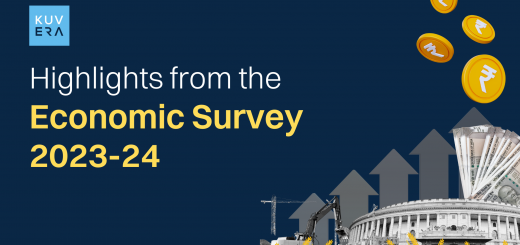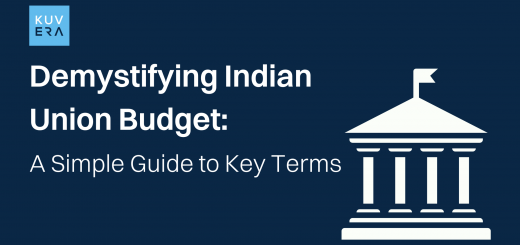In a world where the economy is as dynamic as ever, understanding how households allocate their spending is crucial. The Government of India’s recent release of the “Household Consumption Expenditure Survey 2022-23” provides a deep dive into the spending habits of Indian families. The last report was released in 2011-12.
Urban vs. Rural Spending in 2022-23
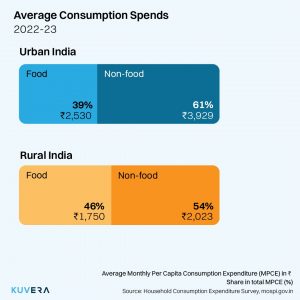
The survey reveals a clear distinction between urban and rural expenditure patterns. In rural India, the Monthly Per Capita Consumption Expenditure (MPCE) stands at ₹3,773, while urban regions report a higher figure of ₹6,459.
- Trending Consumption Expenditure
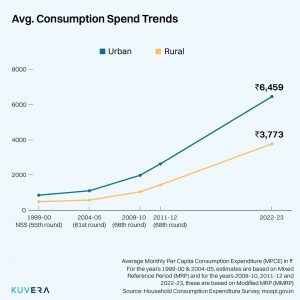
Over the years, there’s been a proportional increase in per capita spending across both urban and rural demographics. This trend highlights the growing consumer market in India and the potential for businesses targeting both sectors.
- A Shift Towards Processed Food
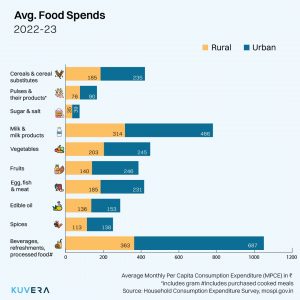
A significant shift noted in the survey is the increased expenditure on beverages, refreshments, and processed food. From 2011-12 to 2022-23, spending in these categories has risen from ₹113 (rural) and ₹236 (urban) to ₹363 and ₹687, respectively. This change signals a transformation in dietary preferences and possibly the influence of urbanization and increased disposable income.
The Consumption Pyramid
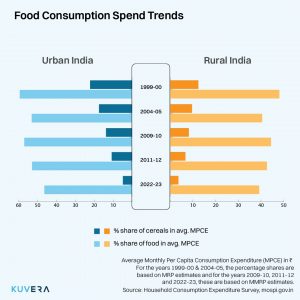
The survey also sheds light on the spending habits across different income groups, maintaining the 2012 poverty line at ₹816 for rural and ₹1,000 for urban areas. Interestingly, the bottom 5% now spends an average of ₹1,373 (rural) and ₹2,001 (urban), while the top 5% expenditure is at ₹10,581 (rural) and ₹20,846 (urban), illustrating the economic disparities within the country.
- Non-food Expenditure on the Rise
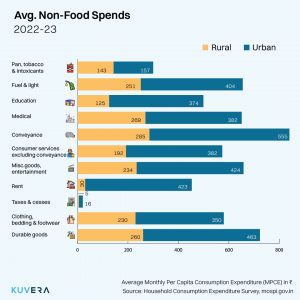
There’s a noticeable increase in discretionary spending, particularly on conveyance, consumer services, and durable goods like televisions and fridges. This rise is indicative of an improving standard of living and the prioritization of comfort and convenience in both rural and urban households.
- Dietary Changes with Income

As incomes rise, the proportion of expenditure on food decreases. In urban India, food spending dropped from 42.6% in 2011-12 to 39.2% in 2022-23, while rural areas saw a decrease from 53% to 46.4%. This trend points to an increased allocation towards non-essential goods and services as financial conditions improve.
- State-wise Rural -Urban Expenditure
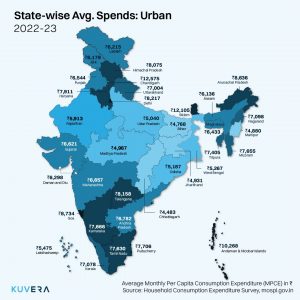
Sikkim leads state-wise expenditure in both urban (₹12,125) and rural (₹7,787) areas, with Chhattisgarh trailing at the bottom. Furthermore, the gap in average consumption expenditure between rural and urban areas is most significant in Meghalaya at 83%, highlighting the uneven development and income distribution across the country.
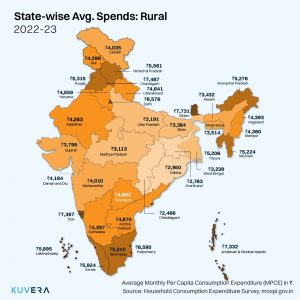
The “Household Consumption Expenditure Survey 2022-23” offers a comprehensive look into how Indian households are navigating their financial waters, revealing patterns of growing consumerism, changing food habits, and the stark contrast in urban and rural lifestyles. These insights are not only vital for policymakers aiming to address disparities and foster equitable growth but also for businesses strategizing to meet the evolving needs of the Indian market.
Interested in how we think about the markets?
Read more: Zen And The Art Of Investing
Watch here: ELSS: Saving tax through mutual funds
Start investing through a platform that brings goal planning and investing to your fingertips. Visit kuvera.in to discover Direct Plans and Fixed Deposits and start investing today.



